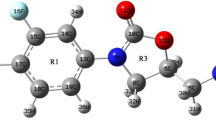Abstract
Using the methods of molecular simulation and HyperChem v.5.0 programs (PM3 method), we carried out calculations of the principal spectroscopic characteristics and of the structure of the laurdan molecule in the ground and the first excited electronic states. The thermal static distribution of molecules over various possible orientations ϕ of the plane of methyl groups relative to the plane of the naphthalene bicycle was taken into account. The energies and dipole moments of these electronic states have been calculated as functions of the torsion angle of methyl groups. The existence of an additional mechanism of electronic spectrum broadening is shown; it is associated with thermal mismatch of the equilibrium orientations of the rotational fragment of the molecule and with the dependence of the electron transition frequency on the degree of deviation of the angle ϕ from the equilibrium value. The dependence of dipole moments on this angle has been found and calculated. This dependence is the strongest for the ground state. The maximum values of dipole moments in the ground and excited states are 4.0 and 7.6 D.
Similar content being viewed by others
REFERENCES
G. Weber and F. J. Farris, Biochemistry, 18, 3073–3078 (1979).
M. Viard, J. Gallay, M. Vincent, and M. Paternostre, Biophys. J., 80, 347–359 (2001).
T. Parassi, E. K. Krasnowska, L. Bagatolli, and E. Gratton, J. Fluoresc., 8, No. 4, 365–373 (1998).
E. Lippert, W. Rettig, V. Bonacic-Koutecky, F. Heisel, and J. A. Miehe, in: I. Prigogine and S. A. Rice (eds.), Adv. Chem. Phys., 68 (1987).
G. Duportail, A. P. Demchenko, and A. S. Klymchenko, FEBS Lett., 508, 196–200 (2001).
M. Brozis, K. A. Kozyra, V. I. Tomin, and Yu. Kheldt, Zh. Prikl. Spektrosk, 69, 412–414 (2002).
A. Kawski, B. Kukliński, P. Bojarski, and H. Diehl, Z. Naturforsch., 55a, 817–822 (2000).
N. A. Nemkovich, A. N. Rubinov, and V. I. Tomin, in: J. R. Lakowicz (ed.), Topics in Fluorescence Spectroscopy,Principles, Vol. 2, Plenum Press, New York-London (1991), pp. 367–428.
M. Viard, J. Gallay, M. Vincent, O. Meyer, B. Robert, and M. Paternostre, Biophys. J., 73, 2221–2234 (1997).
Author information
Authors and Affiliations
Rights and permissions
About this article
Cite this article
Brozis, M., Tomin, V.I. & Heldt, J. Electron Energies, Dipole Electric Moments, and Distribution of the Laurdan Molecule over the Conformation States of Methyl Groups. Journal of Applied Spectroscopy 69, 679–682 (2002). https://doi.org/10.1023/A:1021592509738
Issue Date:
DOI: https://doi.org/10.1023/A:1021592509738




